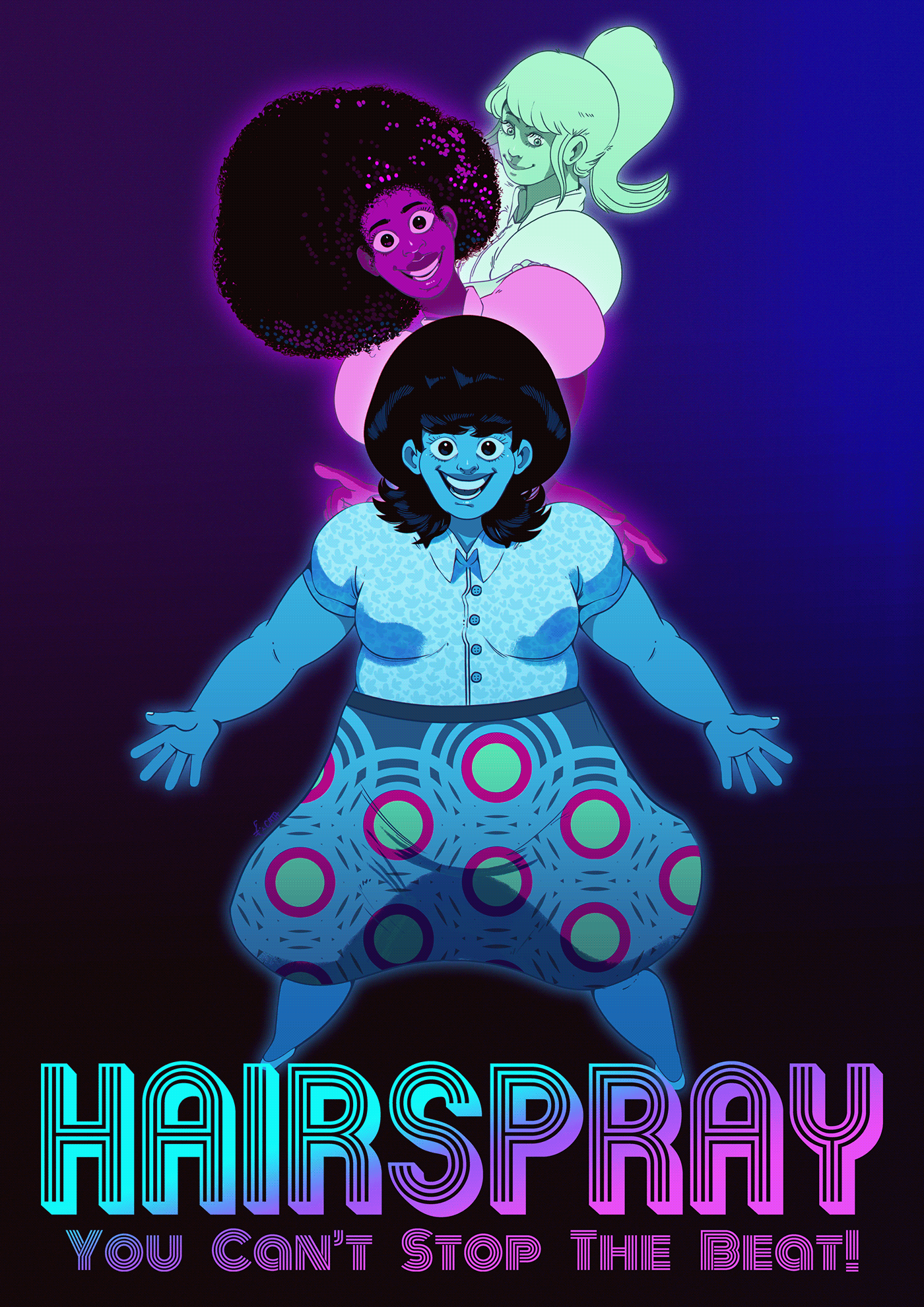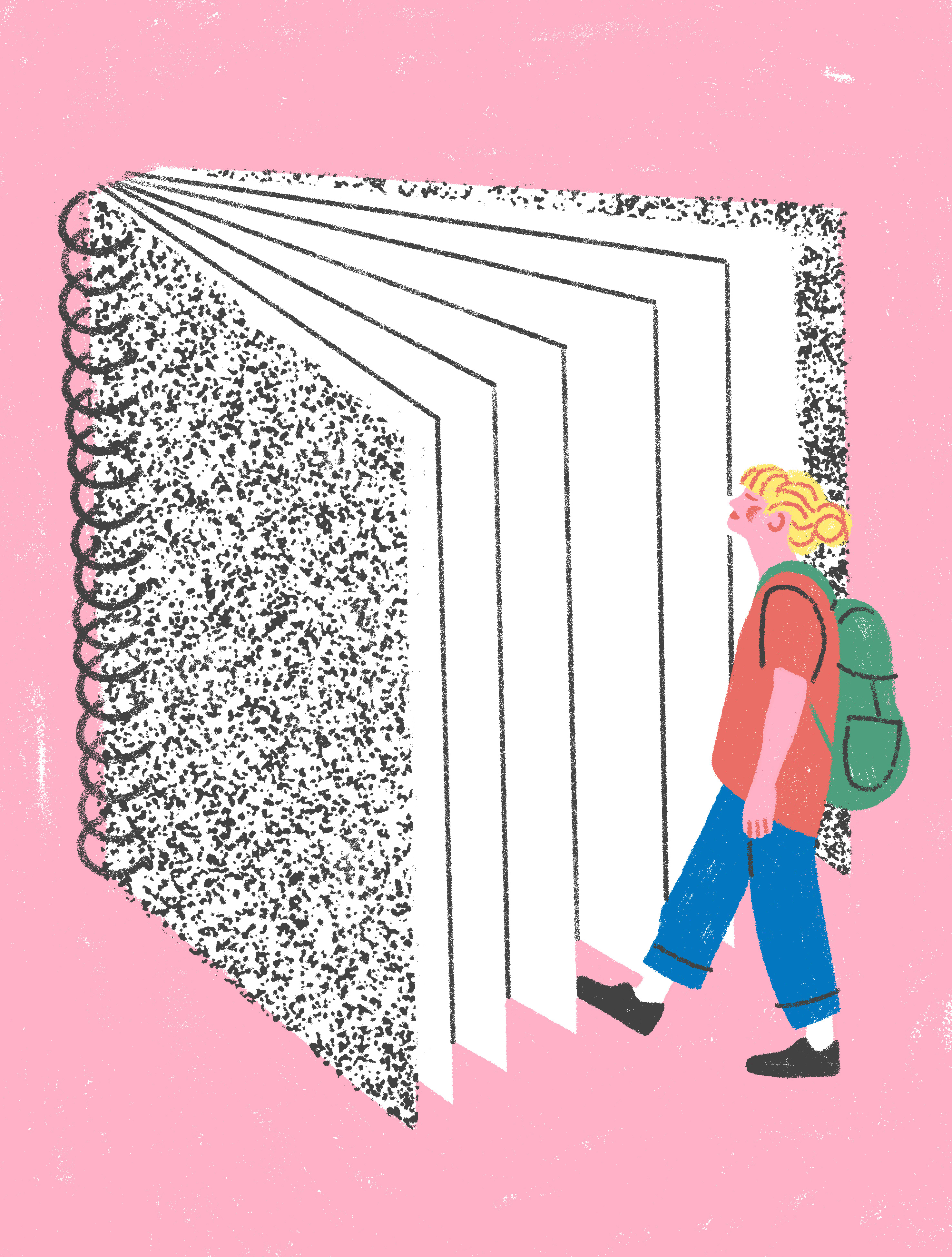
Proposta de ilustrações para playbills de promoção da música You Can’t Stop the Beat do musical Hairspray para a #CollabOMusical
Illustrations for playbills promoting the song You Can’t Stop the Beat from the musical Hairspray for the #CollabOMusical
Explicações sobre o desenvolvimento do projeto disponíveis em português e inglês.
Explanations about the development of the project are available in Portuguese and English.

CONCEITO
CONCEPTION
Hairspray é um musical que, ao todo, possui três versões, que foram executadas em diferentes épocas: A primeira foi feita como um filme musical em 1988 e é considerada a versão original da narrativa; a segunda foi uma versão para os teatros, realizada pela Broadway em 2002, que, fora algumas pequenas diferenças e adaptações, mantêm muito da ideia original proposta pelo filme de 1988, e a terceira versão trata-se de um remake cinematográfico, realizado em 2007, feito a partir do musical teatral de 2002, mas que apresenta mudanças significativas em relação à história original.
Hairspray is an American musical that has three versions, which were performed at different times: The first version was made as a musical film in 1988 and is considered the original version;the second version was a theatrical musical performed by Broadway in 2002, which maintains much of the original idea proposed by the 1988 film, and the third version is a cinematic remake, made in 2007, most inspired by the Broadway's theatrical musical, but which presents significant changes in relation to the original story.
A história do musical Hairspray se passa nos Estados Unidos da década de 1960 (mais especificamente em 1962, na cidade de Baltimore, pelo menos de acordo com a versão de 2007). É muito importante ter essa informação de localização em mente, porque justamente nesse período ocorria um processo de segregação racial muito forte nos EUA, bem como uma mobilização igualmente forte pela igualdade racial, um dos temas que mais se destaca neste musical.
The story of the musical Hairspray takes place in the US in the 1960s (more specifically in 1962, in the city of Baltimore, according to the 2007 version). It is very important to keep this information in mind, because it was precisely during this period that there was a very strong racial segregation process in the USA, as well as a strong mobilization for racial equality, one of the most prominent themes in this musical.




Para discutir temas como o da (des)igualdade racial, bem como da quebra de padrões, do respeito às diferenças, da gordofobia, da importância da mobilização da juventude, entre outros, Hairspray utiliza como cenário um programa de auditório fictício de televisão (muito comuns da década de 1960), que propõe um concurso para eleger a chamada Miss Hairspray (o nome seria uma alusão aos penteados extravagantes da época). A personagem Tracy Turnblad é uma jovem que adora dançar e sonha em aparecer no tal programa e fazer sucesso. Sua mãe, Edna Turnblad, teme que sua filha vire alvo de chacota na televisão, já que Tracy é uma garota gorda, o que, para a mesma, não significa nada. A história se desenrola entre altos e baixos, com direito a uma manifestação contra a política do programa de televisão, que permitia que apenas que artistas negros se apresentassem em um dia específico da semana, uma vez por mês, disputas entre Tracy e Amber Von Tussle, uma garota metida e que se diverte humilhando os outros, um romance interracial, algo extremamente polêmico na época, entre outras aventuras!
To discuss themes such as racial (in)equality, as well as the respect for differences, fat-phobia, the importance of youth mobilization, etc., Hairspray uses a fictional TV program, which proposes a contest to choose the Miss Hairspray (the name would be an allusion to the extravagant hairstyles in 1960's). The character Tracy Turnblad is a young woman who loves to dance and dreams of appearing in the program. Her mother, Edna Turnblad, fears that her daughter will become laughed at due to her weight, but Tracy see no problem about that and follow your dream. The story unfolds between ups and downs, entitled to a demonstration against the policy of the television program, which allowed only black artists to perform on a specific day of the week, once a month; disputes between Tracy and Amber Von Tussle , a spoiled girl who has fun humiliating others, an interracial romance, something extremely controversial at the time, etc.
A diferença entre as versões de Hairspray se encontra mais nítida ao final da história, algo que me inspirou a fazer duas versões diferentes de playbill. Apesar da importância significativa da personagem da Tracy para a história, o fato de ela ganhar o concurso Miss Hairspray tanto na versão de 1988 e 2002 me pareceu demasiadamente anticlimática. O que ocorre é que, ao ganhar o concurso, Tracy se torna uma “embaixadora pela luta à inclusão” e determina que o programa apresente artistas negros todos os dias. O problema é que existe uma personagem negra (seu nome varia de acordo com as versões), amiga de Tracy e que também estava concorrendo ao título, que simplesmente foi cortada do concurso por ser negra. Caberia muito bem na narrativa que a grande virada do roteiro fosse justamente a coroação dessa personagem (o que ocorre de forma fantástica na versão de 2007), principalmente porque se encaixaria perfeitamente com a oposição entre o bom coração e o valor da amizade propostos por Tracy contra a inveja e a soberba da personagem Amber, a perdedora. Além disso, representaria que a luta por igualdade e justiça valeria a pena, mesmo que o caminho para alcançá-las fosse difícil.
The difference between the versions of Hairspray is clearer at the end of the story, something that inspired me to make two different versions of playbill. Despite the significant importance of Tracy's character to the story, the fact that she won the Miss Hairspray contest in both the 1988 and 2002 versions seemed to me too anti-climatic. When she wins the contest, Tracy becomes an “ambassador for the equality and inclusion” and determines that the TV program presents black artists every day. The problem is that there is a black character (her name varies according to the versions), a friend of Tracy and who was also competing for the Miss Hairspray title, who was simply cut out of the contest because she is black. It would fit very well in the Hairspray central narrative that the turning point of the script was precisely the crowning of this black character as the winner (which occurs in a fantastic way in the 2007 version), mainly because it creates the perfectly opposition between the good heart and the value of friendship proposed by Tracy against the envy and pride of the character Amber, the contest loser. In addition, it would represent that the fight for equality and justice would be worthwhile, even if the path to reach them was difficult.


Enfim, chega de muitas explicações! Aqui estão as minhas versões de playbill representando a Inez Stubbs ou “Pequena Inez” (nome da personagem negra, de acordo com a versão de 2007) e Tracy como as personagens incríveis desse musical maravilhoso.
Anyway, here are my versions of the playbill representing Inez Stubbs or “Little Inez” (name of the black character, according to the 2007 version) and Tracy as incredible characters in this wonderful musical.



OBRIGADA!
THANK YOU!




